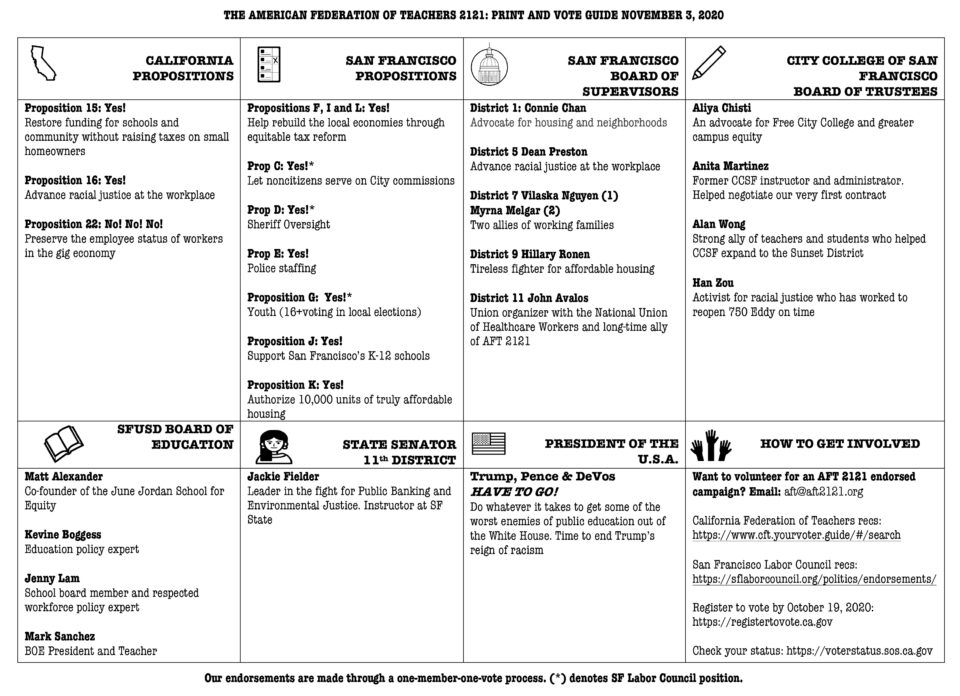CONTRACT NEGOTIATIONS
Bargaining moves to compensation,
part-time parity
By Marianne Kaletzky, AFT 1493 Executive Secretary
After settling the MOU for Summer and Fall 2020, AFT and the District returned to negotiations for a multi-year contract. Discussions have focused on three issues that have long been major priorities for the union: workload, compensation, and part-time parity. As has been announced earlier and is summarized below, tentative agreements have been reached on a new workload plan for full-time faculty and new provisions for full-time faculty workweeks.
District’s most recent compensation proposal
The parties are currently negotiating over compensation and benefits, including part-time parity. Last Monday, the District presented AFT with its most recent counter-proposal on compensation, which maintains the current Total Compensation Formula (in which 80% of all newly assessed property tax revenue is divided among employee groups, and each group is responsible for deciding how to allocate their funds to compensation and benefits). In addition to the funds from the Formula, the District also made a one-time offer of about $400,000 towards part-time parity and a one-time increase in medical caps of $50 for individual, two-party, or family coverage. The District proposed that labs be loaded at .8 FLC per hour.
AFT’s counterproposal
In response, AFT presented a proposal asking the District for a greater commitment to part-time parity. The union is proposing that the District agree to a parity goal of 85% and outline a series of concrete, timely steps to achieve it. In addition, AFT is proposing that part-time instructors:
- get paid by FLC rather than by the hour. Hourly pay has long resulted in the drastic undercompensation of part-time instructors, since they are not paid for prep time or grading.
- get paid on a “mirror schedule” to full-time instructors beginning in the 2021-2022 school year—meaning that the adjunct salary schedule would include every column and step that appears on the full-time salary schedule. Previously, part-time instructors with a terminal degree and part-timers with many years of experience were especially disadvantaged by their adjunct status, since the part-time schedule does not include different columns for education levels and only has 11 steps.
- for the 2021-2022 school year, earn 80% of the salary paid to a full-timer with the same education and experience teaching the same FLC. The District would be expected to increase adjunct salaries to achieve the parity goal of 85% over two academic years.
AFT’s current proposal also asks for a recurring increase in medical premium caps for full-timers. Under the union’s proposal, the amount the District pays in premiums would increase by $50 per month for individual coverage, $75 per month for two-party coverage, and $100 per month for family coverage for three successive years. The increase would be applied on January 1st of 2020, 2021, and 2022, with the increases for 2021 and 2022 adding to the increases in previous years. For part-timers, the maximum healthcare reimbursement would increase by $600 per semester in each of the three years, for a stipend of $2105 per semester effective January 1, 2020; $2705 per semester effective January 1, 2021; and $3305 per semester effective January 1, 2022.
AFT continues to propose .85 FLC for lab rates
The union’s current compensation and benefits proposal also loads labs at .85 FLC per hour across science, art, music, PE, and KAD.
District negotiators to discuss AFT’s proposal with Board members on Oct. 28
After receiving the union’s proposal on Thursday, District negotiators said that they needed to go back to the Board of Trustees to get authorization to offer additional “on-schedule” funds. District negotiators will speak with the Board on October 28th, with further negotiations sessions between AFT and SMCCD to follow.
Reviewing tentative agreements on full-time workload and workweeks
AFT had demanded for decades that SMCCD quantify the service work of full-time faculty so as to establish more reasonable expectations—and this summer, District negotiators finally agreed. AFT and the District agreed on the terms for a pilot program that will use a points system to ensure a fair workload for each full-timer. Various service activities will earn between .5 and 4 points every year, and each full-time faculty member will be responsible for completing a Professional Responsibilities Plan of 6-7 (instructors), 5 (counselors), or 4 (librarians) points per year. (Nurses and faculty assigned to other duties, like instructional designers, will not be responsible for completing a Professional Responsibilities Plan.) The pilot program will be in effect for academic years 2021-2022 and 2022-2023, with faculty making their first Professional Responsibilities Plans in May 2021 for the coming year.
After settling workload, the parties negotiated new provisions for faculty workweeks. The revised version of Article 7 stipulates fewer required on-campus hours for instructional faculty, even once in-person education resumes: full-time instructors will only be required to be on campus for their courses and office hours, rather than for 25 hours per week. The revised Article 7 also increases full-time counselors’ non-appointment “prof time” from 5 to 8 hours per week and gives counselors a voice in appointment scheduling practices.

